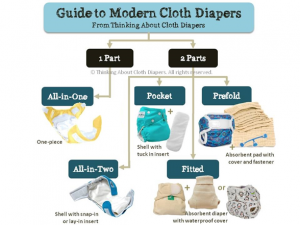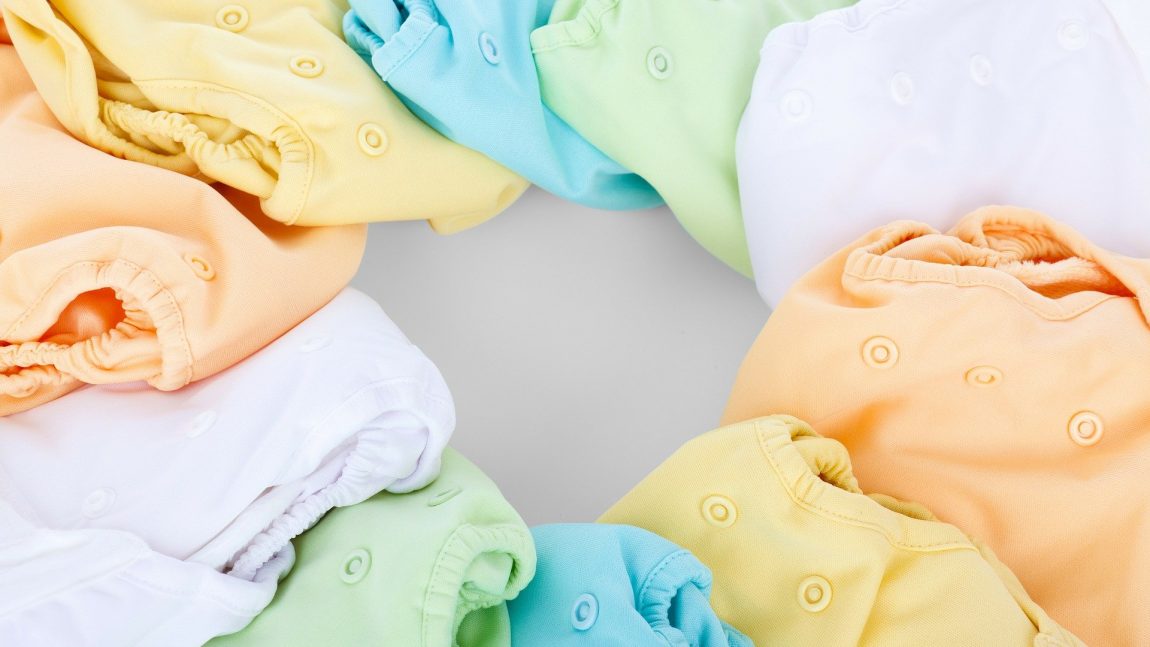Awaiting for a baby’s arrival is exciting – soon-to-be parents are thrilled at the idea of introducing the little one to family members, settling in the house, and showering him or her with lots and lots of cuddles and kisses. However, babies also mean endless diaper changes and smelly, overflowing trash cans. While I can’t help with the diaper changes themselves, I can offer some hope for the environmentally and cost-conscious folks out there – disposable diapers and smelly trash cans do NOT have to be the standard!
Cloth diapers are making a comeback, saving parents from spending large sums on Pampers and Huggies, and saving the environment from thousands of diapers going to local landfills. When cloth diapers are mentioned, it often conjures thoughts of flour sacks and diaper pins, not to mention the difficult work of keeping them clean daily. I am here to relieve you of those thoughts and let you know cloth diapers have come a long way in the past couple of decades!
Cloth diapers today are versatile, as easy to put on as a disposable diaper, machine washable, and, dare I say, cute! The “fluff butt” as it’s affectionately known due to the fact that cloth diapers are somewhat bulkier than disposables, is loved by cloth diapering parents who seek fun and aesthetically-pleasing designs and embrace surrounding their babies with more natural products to avoid the chemicals and plastics in disposable diapers, such as VOCs, chlorine, dyes, fragrances, phthalates, and more. Furthermore, cloth diapers can last for several children in a family to have an even deeper positive impact on finances and the environment.
The Environmental Impact of Cloth Diapers
I have kept track of my cloth diaper washes and resource use so that I would have real-world numbers to keep me motivated. In 26 months of cloth diapering across two children (and my youngest is 16 months old, so a few more months to go!), we avoided 6,500 diapers from going to landfill and saved the equivalent of $2,400 in disposable diapers and wipes.
Accounting for washing costs (water, electricity, gas for water heater, laundry detergent), which add up to ~$1.75 per wash day, and upfront costs of cloth diapers (30 diapers, which in retrospect is too many!) and accessories, this sums up to net savings of approximately $900. The diapers also have a decent resale value. While I could recoup about $200-300, I will likely donate them to a family in need.
It can feel a little lonely in the cloth diaper world, but soon enough others will join you. I’ve read countless stories of spouses who refused to participate, only to realize there are so many benefits to using cloth and were on board soon after. My mother herself was anti-cloth diapers and proudly announced at my baby shower that in her home, she will use disposables! Once I showed her all she needed to do was place the dirty diaper in the lined wet bag and that I would take care of the diaper at my house, she realized it was no different than throwing a disposable diaper in the trash, except that her trashcan would not be smelly until trash day.
My daycare is also very accommodating and simply places all the diapers in the wet bag. I repeatedly asked the teachers if they were okay with this throughout the year and they all said this was not any more work for them than disposables.
Supplies You’ll Need for Cloth Diapering
To start, you’ll need 15-25 cloth diapers (enough for 2-3 days), a diaper sprayer (not necessary but highly recommended and doubles as a bidet attachment!), and a place to store diapers until wash day such as a diaper pail and/or lined wet bags. I also have cloth wipes that I keep moist in a wipe warmer and wash with the diapers. It’s no extra work and helps me save on baby wipes as well. These supplies may all be purchased new or bought secondhand to save money.
You’ll have to decide which kind of cloth diaper works for you. Regardless of the type, cloth diapers are assembled together by providing two layers: a waterproof shell or “cover” (to contain the mess inside the diaper and not spread to clothes, sofas, etc.) and an absorbent layer (usually cotton, microfiber, hemp, etc.).
Here’s a helpful visual guide to the different cloth diaper options from Thinking About Cloth Diapers with descriptions and prices further below:

Here are the main types of cloth diapers, from easiest and most expensive to more hands-on but more affordable and with greater customization capabilities:
- All-In-One: The easiest but more expensive route is the “All-In-One” diaper. This type of cloth diaper has the absorbent fabric layers sewn onto the waterproof shell and most closely resembles a disposable diaper. It’s quick and there’s no guesswork. The diaper is used once before it needs to be washed. You can’t remove the sewn-in absorbent layers and while you can add thinner layers for extra absorbency, it will result in a bulky diaper. They usually run $20-25 each.
- All-In-Twos: All-In-Twos are very similar to All-in-Ones except that an absorbent layer is snapped inside the diaper instead of being already sewn in, providing a little flexibility in the type of absorbent layer. Some even come with a disposable insert to make it easier while on the go but still help reduce waste by being able to reuse the cover when not dirty.
- Pocket: A step down in price is the “Pocket” diaper. The waterproof shell and a single layer of moisture-wicking material, like fleece, are sewn together along the sides with an opening along the back to insert the absorbent layer(s) yourself. Benefits are that the level of absorbency is customizable by selecting the type of material and quantity, but they have to be put together before each use (or all at once while watching your favorite tv show!). A pocket diaper is about $15-20.
The following diapers have the waterproof shell (cover) separate from the absorbent layers. You put on an absorbent layer first, then put on a cover. You can reuse the cover multiple times if it’s not dirty (usually from poo).
- Fitted: A fitted diaper is an absorbent layer (cotton, hemp, or bamboo) shaped like a diaper, molding to the child’s body to provide a great fit (hence the name). The whole fitted diaper is absorbent all around which makes it a favorite for nighttime cloth diapering. A waterproof shell is needed on top of the fitted. Fitted diapers cost $12-$15, and covers are $8-14 each. The cover can be reused several times if not dirty.
- Flat/Prefold: The most economical route is using “flats,” a simple, single-layer square cloth as an absorbent that you fold in various methods to suit your baby’s needs. It’s held together in place with a “Snappi” (the modern and easy diaper pin) and paired with a waterproof shell. This method does require more folding and know-how. An alternative to flats are prefolds. They are a bit easier because they already have more layers stitched in the middle section and thus require less folding, but this also means fewer folds can be used to suit your baby’s needs. Flats and prefolds need to be changed at each diaper change but the cover can often be reused, so fewer covers are needed. The flats and prefolds are $2-3 each. Covers are $8-14 each.
I personally chose the All-In-Ones to make it easier for family members and daycare to hop on board and help me on my zero waste journey!
How to Clean Cloth Diapers
The process of using cloth diapers is really quite simple. Once you have a dirty diaper, rinse the poo in a toilet with a diaper sprayer (pee diapers do not need to be rinsed), and store in a diaper pail or lined wet bag until wash day.
On wash day, simply toss the diapers (and cloth wipes, if you choose to use those) in the washing machine and run the cycles according to the manufacturer. For my Bumgenius Elemental diapers, it’s a short cold wash followed by a hot wash and extra rinse, then in the dryer on low for 30 minutes. And done!
With cloth diapers, I never run out of diapers, there are no chemicals and plastics on my little one all day, diapers are saved from landfill, and I’m not throwing money in the trash by purchasing disposables.
Additional Considerations for Cloth Diapering
Purchase enough cloth diapers for two to three days worth of diaper changes, about 8-12 a day for newborns, 6-9 for under a year of age, and 5-8 for older children. To avoid any odors and bacterial development, wash day should be about every two to three days. When laundering cloth diapers, I first tried cloth diaper-safe detergent, but found that the more effective option was Tide powder detergent.
Do NOT use regular diaper cream with cloth diapers. The petroleum in the cream coats the absorbent fibers, making them water repellent. After coming into contact with regular diaper cream, cloth diapers will no longer absorb liquids. Use cloth-diaper safe creams only.
Baby may need to be dressed in clothes a size up a little bit sooner than if he/she were in disposable diapers since cloth diapers need a little more room.
Finally, know that it’s ok to use disposables when needed! If cloth diapers don’t work for you in certain situations (while traveling, treating diaper rash with diaper cream, nighttime, etc.), temporarily use disposables and go back to cloth when you can. Any progress toward lower waste is helpful – there’s no need to be perfect.
Getting Started
There are lots of resources to help guide parents and caregivers on using cloth diapers. A post about the basics of cloth diapering on my favorite home DIY blog, Young House Love, was what first sparked my intrigue in cloth diapering. With lots of FAQs and recommendations, ClothDiapersForBeginners.com is another website I found helpful when getting started. The Reddit community r/clothdiaps is a great resource to ask questions and receive support for the cloth diapering community.
Enjoy the cloth diaper journey and those fluff butts!
About Gwinnett Recycles: Gwinnett Recycles is focused on helping Gwinnett County, the second-largest county in the state of Georgia, reduce, reuse, compost, and recycle more material and keep waste out of landfills and the environment. Gwinnett Recycles is run 100% independently by citizen volunteers. To connect with us and support our efforts, follow us on Facebook and Instagram, subscribe to our newsletter, and consider volunteering with us!


Add Comment